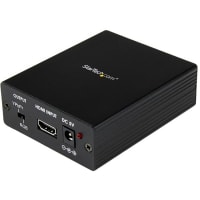Signal Conditioning & Signal Converters
Signal conditioning is a common process that uses converters to prepare analog signals for digitization. To do this seamlessly, high quality, functional conditioners are required as these accurately transfer the signal from sensors to industrial current signals and to other applications.
At RS, you will find a range of signal conditioners, such as signal converters and other tools that will help with your signal conditioning application. We have a full selection in stock from brands including Brainboxes, Advantech, and Cynergy3 Components, and different types of conditioners, such as inverter modules, universal transmitters, and isolating signal converters.
Read on to find out more about signal conditioning, how it works, and the different types of converters.
What is signal conditioning?
Signal conditioning is a process in electronics that enables data acquisition. It is when a device is used to convert one type of signal so that it is modified in a way that makes it ready for the next part of the processing phase.
There are different applications for signal conditioning, including analog to digital signal converter, where current or voltage-limiting and anti-aliasing filtering are used. It is also used in power electronics when it scales back signal in order for it to be at an acceptable level for a microprocessor.
Control engineering is another example of where we see signal conditioning applied. Here, signal conditioning is the stage in a larger process that starts with a sensor stage. Signal conditioning follows this sensing stage and is where the signal tends to be amplified before the third part of the process sees the signal processed.
How does signal conditioning work?
The instrument used in signal conditioning is known as a signal conditioner. There are different types of signal conditioners that are applied based on measurement, however they are all used to convert one type of mechanical or electrical signal, which is referred to as the input signal, into another type of signal, known as the output signal.
Its primary use is to amplify and convert a signal that may be difficult to read using conventional instruments into a more easily read format. This then makes it compatible for machine control or data acquisition.
What is signal conditioning used for?
Signal conditioning has different applications. These are some of the main functions of different signal conditioners:
- Signal conversion
Converting the signal is the main purpose of a signal conditioner. These signal converters will pick up the signal and convert it into a higher level of electrical output.
The most common use of signal conversion is in industrial settings where a variety of sensors are used to obtain measurements. If there is a large number of sensors being used at once, as is common in large-scale, industrial applications, the different signals that are generated may need to be converted for the readings to be useable for the instruments they are connected to.
- Amplifying
Signal amplification is where a signal processor amplifies the signal so that it is ready for digitization or processing. Amplification can be carried out by either increasing the resolution of the input signal or by increasing the signal-to-noise ratio.
Signal conditioning uses amplifiers for different purposes. For instance, instrumentation amplifiers are optimized for DC signals, while isolation amplifiers are used to isolate high DC levels from the device while the AC signal is being converted.
- Linearization
Some signal conditioners can perform linearization. This is where signals that are produced by the sensor do not line up with the measurement. The conditioner reads and interprets the signal. Linearization is often used in thermocouple signals.
- Filtering
When the signal frequency is filtered using valid data and blocks any noise, this is known as filtering. Conditioners can perform this filtering function and are made from either active and passive components or a digital algorithm.
What are the different signal conditioner types?
There are different types of signal conditioner, each designed to perform a certain function as outlined above. For instance, a DIN rail signal conditioner mounts on a DIN rail bracket. These are popular in industrial applications as they provide a combination of practicality and purpose.
If you are measuring temperature, you may find that as well as amplifying the signals generated by thermocouples, signal conditioning is needed to connect the instrument for temperature measurement. Thermocouple signal conductors compensate for any variations and false readings.
You can also search by output type. If you are looking for a signal conditioner for a 4-20 mA current rating, isolating amplifiers can be the ideal solution.
Why choose RS for signal conditioning and converters?
At RS, we stock a full range of signal conditioners that are designed to help convert the signal accurately and efficiently. You can use the search function to narrow your search by manufacturer, output type, and current.
We are a leading authorized distributor of signal conditioning converters in North America. We stock leading names and our conditioners meet the highest industry and safety standards.
Should you have any questions, our team is on hand to help. Contact us today for advice from us. You can also find advice in our expert content hub.










